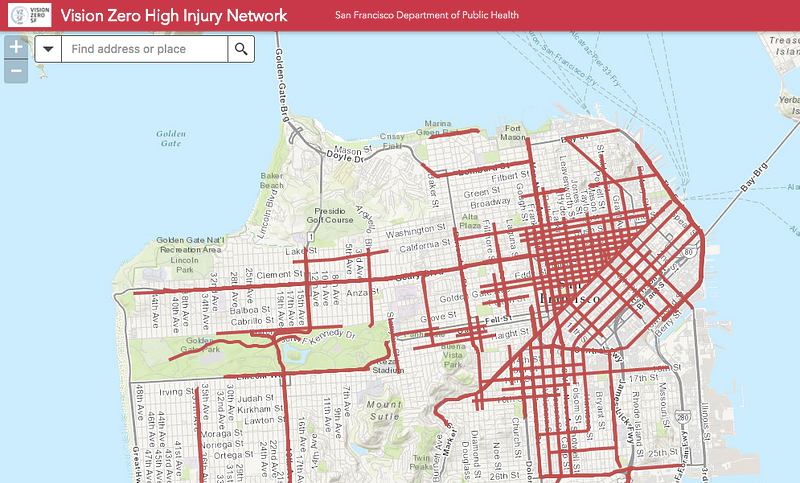abhi nemani at Medium: “…Auto collisions with bikes (and also pedestrians) poses a real threat to the safety and wellbeing of residents. But more than temporary injuries, auto collisions with bikes and pedestrians can kill people. And it does at an alarming rate. According to the city, “Every year in San Francisco, about 30 people lose their lives and over 200 more are seriously injured while traveling on city streets.”…
Problem -> Data Analysis
The city government, in good fashion, made a commitment to do something about. But in better fashion, they decided to do so in a data-driven way. And they tasked the Department of Public Health in collaboration with theDepartment of Transportation to develop policy. What’s impressive is that instead of some blanket policy or mandate, they opted to study the problem,take a nuanced approach, and put data first.

The SF team ran a series of data-driven analytics to determine the causes of these collisions. They developed TransBase to continuously map and visualize traffic incidents throughout the city. Using this platform, then, they developed the “high injury network” — they key places where most problems happen; or as they put it, “to identify where the most investments in engineering, education and enforcement should be focused to have the biggest impact in reducing fatalities and severe injuries.” Turns out that, just12 percent of intersections result in 70% of major injuries. This is using data to make what might seem like an intractable problem, tractable….
Data Analysis -> Policy
So now what? Well, this month, Mayor Ed Lee signed an executive directive to challenge the city to implement these findings under the banner of“Vision Zero”: a goal of reducing auto/pedestrian/bike collision deaths to zero by 2024….
Fortunately, San Francisco took the next step: they put their data to work.
Policy -> Implementation
This week, the city of San Francisco announced plans to build its first“Protected Intersection”:
“Protected intersections use a simple design concept to make everyone safer.Under this configuration, features like concrete islands placed at the cornersslow turning cars and physically separate people biking and driving. They alsoposition turning drivers at an angle that makes it easier for them to see andyield to people walking and biking crossing their path.”
That’s apparently just the start: plans are underway for other intersections,protected bike lanes, and more. Biking and walking in San Francisco is about to become much safer. (Though maybe not easier: the hills — they’rethe worst.)
***
There is ample talk of “Data-Driven Policy” — indeed, I’ve written about it myself — but too often we get lost in the abstract or theoretical….(More)”